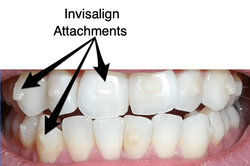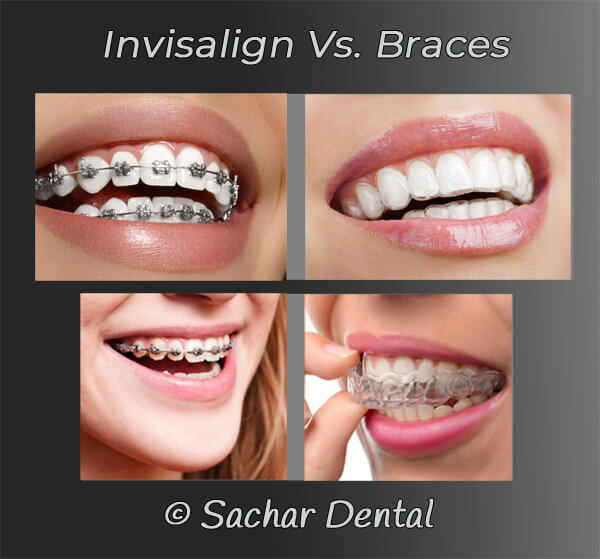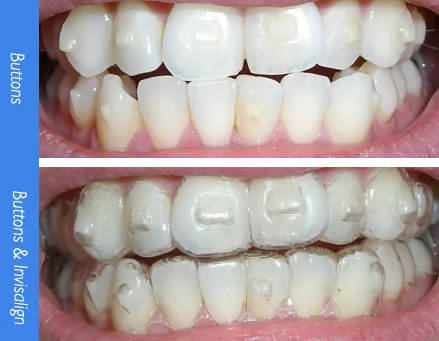Invisalign vs. Traditional Braces: Which Alternative Is Right for You?
When considering orthodontic treatment, the selection in between Invisalign and traditional braces provides numerous important aspects that warrant careful examination. Invisalign supplies a discreet alternative with removable aligners, while conventional braces give an extra noticeable yet reliable remedy for extreme imbalance. Each alternative encompasses distinct benefits and disadvantages associated with aesthetic appeals, convenience, therapy period, and cost. Comprehending these nuances is important for making a notified choice that straightens with your individual choices and way of living. The inquiry continues to be: which option will best meet your orthodontic requirements and assumptions?
Summary of Therapy Alternatives

In comparison, standard dental braces contain steel brackets and wires that are bonded to the teeth. This approach uses constant pressure over time to achieve alignment. While reliable for intricate orthodontic problems, standard braces need normal visits for modifications and can posture difficulties in keeping oral health because of the problem of cleaning around wires and braces.
Both options have their qualities, and the choice typically pivots on specific dental problems, way of living preferences, and individual compliance. Inevitably, getting in touch with an orthodontic professional is essential for identifying the most ideal therapy plan tailored to specific demands. Comprehending the subtleties of each alternative can dramatically affect the overall success of orthodontic therapy.
Aesthetic Factors To Consider
A considerable aspect affecting the selection in between Invisalign and typical braces is the aesthetic allure each therapy provides. Invisalign aligners are crafted from clear plastic, making them basically unnoticeable when put on.
In contrast, conventional braces contain metal braces and cables, which can be a lot more visible. While improvements in orthodontic innovation have actually caused the growth of smaller brackets and tinted elastics, typical braces still keep an even more obvious account. For some people, the exposure of braces may hinder them from seeking necessary treatment.
Eventually, the selection in between Invisalign and conventional dental braces might hinge on personal preferences concerning aesthetics. Patients that prioritize discernment commonly lean toward Invisalign, while those who are much less worried about exposure may select conventional dental braces. Recognizing the visual ramifications of each option is essential for making an informed choice that aligns with one's way of life and preferences.
Comfort and Convenience

In terms of comfort, Invisalign aligners are removable, allowing patients to enjoy their favorite foods without restriction and keep ideal oral health. Cleaning and flossing are simplified, as the aligners can be obtained during these regimens, whereas typical braces require cautious maneuvering around brackets and wires.
In comparison, conventional braces necessitate regular changes, making them much less hassle-free for those with hectic routines. Generally, the convenience and ease of Invisalign make it an attractive choice for lots of individuals seeking orthodontic treatment.
Treatment Period and Efficiency
While both Invisalign and conventional dental braces are efficient in fixing oral imbalances, the duration of therapy can differ significantly between the two alternatives. Normally, Invisalign treatment can take anywhere from 12 to 18 months, relying on the complexity of the instance. The clear aligners work by progressively moving teeth right into their preferred placements, and normal follow-ups with an orthodontist assistance guarantee development stays on the right track.
On the other hand, traditional braces often need a longer dedication, normally varying from 18 months to 3 years. This is because of their set nature and using brackets my blog and cords, which can be extra efficient for complicated instances and serious misalignments (Invisalign). The treatment performance of typical dental braces is well-documented, as they permit specific adjustments and higher control over tooth movement
Eventually, the choice in between Invisalign and traditional braces might hinge on both the expected therapy period and the specific oral problems at hand. Consulting with an orthodontist is essential, as they can supply customized recommendations based upon individual needs, making certain the selected method lines up with desired results and timeframes.
Cost Comparison and Insurance Policy Alternatives
Expense plays a substantial role in the decision-making procedure for individuals taking into consideration orthodontic treatment, whether choosing Invisalign or standard braces. Usually, the cost of Invisalign ranges from $3,000 to $8,000, while conventional braces commonly set you back between $2,000 and $6,000. Factors influencing these costs include the complexity of the situation, the duration of treatment, and geographical place.
Insurance policy coverage can dramatically affect out-of-pocket expenses. see here now Lots of dental insurance plans give partial protection for orthodontic therapies, however the specifics can differ widely. It is crucial for individuals to review their insurance plan to figure out the extent of protection for either alternative. Normally, typical braces might be more regularly covered by insurance coverage strategies compared to Invisalign, which some insurers categorize as an aesthetic procedure.
Furthermore, a number of orthodontic techniques supply adaptable layaway plan, making both treatment options a lot more accessible. Clients ought to ask regarding possible funding choices and discount rates for ahead of time settlements. Evaluating the overall expense, including insurance coverage benefits and payment plans, is vital for making a notified choice that straightens with both visual choices and budget plan factors to consider.

Conclusion
In summary, the option in between Invisalign and standard dental braces pivots on numerous variables, including aesthetic choices, convenience, treatment duration, and price. Invisalign provides a very discreet, detachable choice that facilitates dental health and dietary versatility, while conventional dental braces might be preferable for complicated dental concerns and commonly come at a lower cost point. Ultimately, assessment with an orthodontist is important to evaluate individual conditions and figure out one of the most proper treatment alternative for attaining ideal oral placement.
When thinking about orthodontic treatment, the selection in between Invisalign and conventional braces offers a number of essential factors that warrant cautious assessment.Comparing Invisalign and traditional braces reveals distinct treatment alternatives for orthodontic correction.While both Invisalign and standard braces are reliable in fixing dental misalignments, the period of therapy can differ substantially in between the two options.Price plays a substantial duty in the decision-making procedure for people thinking about orthodontic treatment, whether deciding for Invisalign or typical dental braces.In summary, the selection between Invisalign and traditional dental braces pivots on numerous elements, consisting of aesthetic preferences, additional reading comfort, treatment period, and cost.